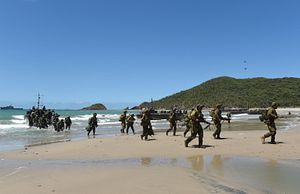Last week, Australia and Singapore concluded the latest iteration of a key maritime exercise. While the drills were just one of several engagements between the two sides, it nonetheless put the spotlight on the ongoing activity within the defense aspect of the relationship among both countries amid wider domestic and regional developments.
As I observed previously in these pages, Australia and Singapore have long maintained a security relationship as part of their wider ties, which were elevated to the level of a comprehensive strategic partnership back in 2013. Beyond the usual components of this aspect of relations such as exchanges and exercises, both countries are longstanding members of the Five Power Defense Arrangements (FPDA) — the oldest standing multilateral security agreement of its kind in the region — and Australia is among the key places where the Singapore military has conducted overseas training, which it considers critical for its development.
Over the past few years, both sides have made an effort to deepen ties even further in this domain, including expanding Singapore’s military facilities in Australia, upgrading existing military exercises, broadening exchanges, and launching new dialogues (see: “The Enduring Strategic Logic of the New Australia-Singapore Military Training Deal”).
One of the manifestations of the exercise component of the defense relationship is Exercise Singaroo. Exercise Singaroo is a bilateral maritime warfare exercise conducted between the Republic of Singapore Navy (RSN) and the Royal Australian Navy (RAN). Exercise Singaroo was first inaugurated by the two sides back in 1995.
From September 14 to September 25, the two sides held the 19th iteration of Exercise Singaroo. The exercise was held in Darwin, Australia and in what was officially characterized as the southern reaches of the South China Sea.
According to Singapore’s defense ministry (MINDEF), during the exercise, the RSN participated with two Victory-class missile corvettes, RSS Valiant and RSS Vigour, embarked with ScanEagle unmanned aerial vehicles (UAVs), while the RAN deployed one Anzac-class frigate, HMAS Stuart, supported by replenishment oiler HMAS Sirius. The sea phase of the exercise included a range of activities including naval surface warfare serials, anti-air gunnery firings, communication exercises, and encounter exercises.
Exercise Singaroo is just one of several defense-related interactions between the two countries, and these are set to continue as well through the year, both in terms of bilateral ones as well as wider minilateral and multilateral ones. Nonetheless, as Australia-Singapore relations continue to develop amid broader domestic, regional, and global trends, the older aspects of defense ties will be important to watch in wider assessments of continuity and change.
































